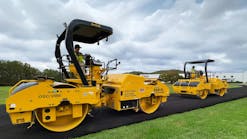The length of the compactor drum is not the true measure of the productive capacity of a compactor.
Volvo Construction Equipment’s experts say that effective drum width (EDW) is the most important metric.
The difference between EDW and drum length can be significant. Generally, these two dimensions are within 10 percent. See “Figure 3” below.
“The width of the paved panel in Figure 3 requires three side-by-side passes of the compactor to provide complete coverage,” says Justin Zupanc, Volvo’s compaction product manager. “Unfortunately, even the best operator will fail to achieve uniform pavement density when making a rolling pattern like the one shown, since the compaction forces are not evenly applied across the width of the panel.
“The fifth pass overlaps the pavement surfaces compacted during the first four passes but gives only a single pass over the middle 18 inches of the panel,” Zupanc says. “This means density will be lowest in the center, slightly higher at the outer quarters of the panel, and highest in the sections where three drum passes were made. This doesn’t meet the necessary requirements. The narrow rolling width also interferes with the ability of the operator to keep up with the paver.”
Zupanc points out that in Figure 4 that only two side-by-side passes are needed to completely cover the same panel width from Figure 3. This is due to a compactor with a wider EDW.
“The well-trained operator on a compactor with 79-inch drums can compact the panel with uniform coverage except in the exact center where the side-by-side passes overlap slightly,” Zupanc says. “Using this breakdown rolling technique will achieve uniform density across the panel and help achieve requirements.”
It’s also possible to have drums that are too wide for the panel. In Figure 5 (below), the compactor drums are 84 inches wide.
The center of the panel is receiving twice as much compaction force as the outer sections.
“Because a compactor with drums too wide for the pavement was used, breakdown rolling results will fail to achieve requirements,” Zupanc says. “In addition, the larger compactor has higher ownership and operating costs, so there’s reduced payback to the contractor on the investment.
He says this is the reason nearly all N.A. marketers produce highway-class compactors with drums in three basic widths: 67, 79, and 84 inches.









